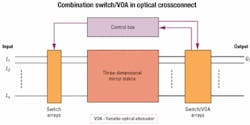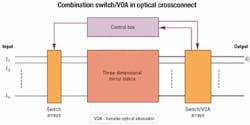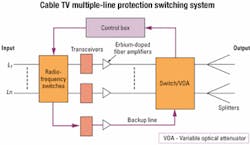MEMS technology for a multifunction switch engine
Developing a chip-level multifunction MEMS engine offers several benefits in cost, technology, and time-to-market.
NAN ZHANG, PHILIP YOUNG, and TOM BREUNIG, MEMSCAP
Now that the hype around the optical-networking market has subsided, the industry is free to step back and refocus. Specifically, it can assess how best to provide the high-speed, high-bandwidth solutions to an "opaque system" market, where the switching and routing technology is predominantly optical-electrical-optical (OEO)-based.
It is reasonable to assume that a shift from an opaque system to a transparent (all-optical) system is inevitable, particularly at the core network. Data-intensive applications will drive and define future needs for network architecture, necessitating higher speeds and greater bandwidth. All-optical core switching will be required for these consolidated, mesh networks.
While the telecommunications industry is reevaluating its attitude on the market and micro-electromechanical systems (MEMS)-based optical-switching technology, it is worthwhile to note that MEMS technology has been a real workhorse, providing low cost robust solutions to automotive, biomedical, and aerospace customers for more than 10 years.
Optical MEMS industry shifts gearsMany of the MEMS startups have shifted their focus from large-matrix (250x250 and above) three-dimensional (3-D) switch devices to two-dimensional (2-D) matrix switches (32x32 or lower), and are further downsizing to low-port-count (1x2, 2x2, or 1x4) 2-D devices. That is partly due to device complexity and the inherent difficulty in controlling them to the required precision demanded by networking applications. Moving from prototyping to millions of units requires significant process modifications and high degrees of automation to offer the yield, reliability, and cost-effectiveness needed to compete with OEO solutions.In contrast to large-matrix devices, low-port-count switches offer a more reliable, cost-competitive approach that can allow equipment manufacturers to move quickly into the high-volume metro and access levels of the network, securing early market share and establishing a beach head in all-optical systems. However, truly taking advantage of MEMS technology requires some "outside the box" thinking.
MEMS is a highly versatile technology and offers the ability to design complete micro-machined systems that can combine-as do full-sized machines-various functions. Developing a chip-level multifunction MEMS engine such as a combined switch/variable optical attenuator (VOA) provides several benefits from a cost, technology, and time-to-market perspective.
First, as the name implies, a multifunction component in a single package offers greater functionality in a smaller footprint, in contrast to two or more separate devices on a circuit board. That can enable, for example, a network provider to reap the benefits of lower-cost systems and reduced real estate by deploying less expensive switch arrays using a VOA at each optical add/drop multiplexer (OADM) output to tune the channel. Additionally, a well-conceived integration of the two functions on a single die can also cut costs by simplifying fiber management, both during packaging and when integrating devices into larger arrays such as optical crossconnects (OXCs).Second, by procuring a multifunction component from a single supplier, subsystem manufacturers can eliminate the costs associated with development, assembly, packaging, and integration of two separate components. A single supplier producing a multifunction component may achieve an 80% yield, while working with two separate entities on separate components may reduce overall yield to 60%. The single-supplier option represents a potential 20% cost savings.
The unseen cost advantage is from increased quality. The correlation between high yields and quality are obvious. The more control a manufacturer has on a process, the tighter the tolerances and higher the quality. Meeting customers' targeted performance goals are therefore easier. At the same time, dealing with one supplier can shorten time-to-market by eliminating the coordination work and costs of dealing with two vendor organizations.
Finally, such an engine can offer the versatility needed for multiple applications and implementations. A proven robust switching/attenuation device (dual-function switch) can provide a scalable and modifiable foundation for various implementations. That means dual-function 1x2 or 2x2 switches could be used in one instance as part of an OXC for signal monitoring/provisioning, attaining a uniform power output across channels. Dual-function 1x2 or 2x2 switches can also be configured for OADMs and signal routing and balancing within metro applications.
Offering both component and integrated MEMS-based solutions advances performance, lowers cost, and increases functionality-all of which can be passed on to the customer. This is value-added manufacturing that in a competitive landscape enables companies not only to survive, but also to flourish.
Assessing a multifunction MEMS
A successful MEMS device is the crystallization of expertise from several disparate technology areas, including specialized materials, design, process, and of course, fiber-optic knowledge. A good supplier will have at minimum state-of-the-art manufacturing facilities and technologists with the requisite expertise to determine the best solution-whether a single-component engine or an integrated multifunction MEMS device for specific application requirements.
A complete solution has the driver electronics embedded in the package. Only a few manufacturers offer switches/VOAs with integrated electronics in a small cost-effective package that can snap directly into the circuit board. Using such a device, a TTL signal is all that is required for control without increasing the size of the footprint.
To fully leverage low-port-count switches, the switch architecture must be fully scalable, allowing subsystem manufacturers to configure arrays of switches using the layouts most appropriate for their applications. As deployment of all-optical networking begins, provisioning for four, eight, and 16 channels will occur before that for larger port configurations.
Risk assessment is an important cost consideration before deployment of any architecture. Lower-port-count devices will have the advantage of proven performance and reliability to meet the needs of the market. Additionally, as engines, these devices should be modifiable so that ports can be added or dropped for different implementations.
Other criteria to assess are fabrication-related, including process, metrology, and manufacturing automation issues. Does the MEMS supplier have the processes in place to improve quality and reduce cost for the customer? Integrating metrology and automation into the manufacturing process enables a manufacturer to remain competitive when non-measurement-oriented suppliers are unable to achieve repeat success. By the same token, an effective metrology system enables an organization to create exacting standards for incoming compositional integrity, ensure repeatability of each operation, and stay within tight tolerances required for each product.
The supplier's fabrication facility should use a high degree of automation and a logical material and product infrastructure. A modular layout enhances repeatability and prevents contamination. In this way, labor overhead costs can be reduced by passing the savings and quality on to the customer.
Robust packaging design
Packaging is another key issue. It is critical that the package have a robust design that meets form fit and function. To ensure performance stability over time, the package must be carefully designed to allow easy integration of the product and protect its contents. For many optical devices, that also means protecting against moisture. Stable optical performance and device reliability can be secured by optimizing package composition, material thickness, and reducing surface area that might allow moisture into the package.
In large-matrix switch systems, 3-D mirror arrays provide signal direction. Maintaining operation in these systems requires some form of redundancy. If a 3-D mirror fails during deployment, the input signal can be rerouted to a redundant mirror by using 2x1 (or 1x2) switches. Using this 1x2 scheme, the system is capable of detecting and redirecting signals intelligently whether or not one particular mirror works normally (see Figure 1).
To maintain signal integrity, a dual switch/VOA device is used. The switch provides the necessary signal feedback and the VOA for the required attenuation. By using switch arrays and switch/VOA arrays, operational integrity for expensive large-port-count matrices can be maintained-avoiding lost or unbalanced signal outputs.
Another application example of such a dual switch/VOA is the OADM module (see Figure 2). To maintain data integrity and prevent damage to other optical components such as receivers, the optical signal intensity must be controlled. A switch/VOA can be used to monitor and attenuate the optical signal to the desired level. Similarly, such switch/VOA devices can be used in a cable television multiple-line protection switching system (see Figure 3).
It's the MEMS
Finally, it's important that your supply entity has a broad knowledge of MEMS as well as fiber-optic technology. Organizations that have specialized in MEMS for a range of applications-especially harsh-environment applications-can typically bring materials, design, and process expertise from other markets to bear on optical applications-and conformance to standards can be easier to meet.
Above all, MEMS switch providers must listen to customers and have the expertise, flexibility, and facilities necessary to meet performance, reliability, and cost expectations.
Nan Zhang is general manager of the optical communications business unit, Philip Young is senior applications engineer, and Tom Breunig is a product marketing team member at MEMSCAP Inc. (San Jose, CA). They can be reached at [email protected], [email protected], and [email protected].



